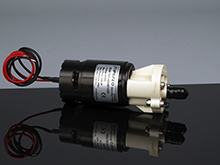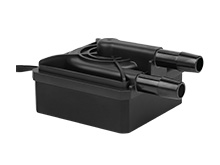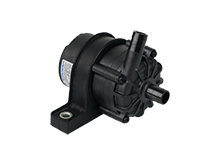Selection and application of chillers cooling circulating water pumps
2023-05-29
Chillers, commonly known as freezers, chillers, ice and water machines, freezers, chillers, etc., are used more widely in various industries.
The chiller is a refrigeration equipment based on the reciprocating cycle of refrigerant. It mainly to provide chilled water to cool down the equipment of various industries, to improve the accuracy of the product and increase the productivity. The principle of operation is the reciprocation of the gaseous cycle of the refrigerant, thus completing the transfer of heat and achieving the effect of refrigeration. The water pump is an important part of the chiller, this article will introduce you to the working principle, selection requirements and application cases of the chiller cooling cycle ring water pump.

- Working principle
A chiller system usually consists of a compressor, condenser, evaporator and water pump.
The water pump is an integral part of the chiller and its main function is to pump the cooling water out of the evaporator, cool it through the condenser and then circulate it back into the evaporator, forming a water cycle. The pump is usually located behind the evaporator or in front of the condenser and is responsible for pumping or pushing the cooling water into the system.
- Selection requirements
The performance of the water pump plays a vital role in controlling the efficiency and energy consumption of the entire chiller system. When selecting a chiller water pump, the following factors need to be taken into account:
Firstly, Water Flow and water head. The pump should have the flow and head to meet the highest operating conditions and to keep the operating condition point in the high efficiency range. The flow and head of the pump should have a margin of 10% to 20%, when the flow is larger, multiple parallel operation can be considered.
The second, Structural design. The water pump needs to have good structural stability and compactness in order to meet the practical requirements for application in chillers. When designing the pump, full consideration needs to be given to the performance of its sealing structure in order to prevent leakage of cooling water and at the same time avoid oxidative corrosion inside the pump body.
Thridly, Energy consumption control. The ability to control energy consumption needs to be fully considered when selecting a liquid-cooled water pump in order to reduce the energy consumption of the system. The operation of a water pump in a chiller consumes a certain amount of electrical energy. Water pumps can be designed to achieve higher efficiency and lower energy consumption by optimising components such as impellers and inlet and outlet piping.
Fourthly, Noise-reducing design. Water pumps produce a certain amount of noise when they are in operation. To reduce the impact of noise on people and the environment, choose a pump with a noise-reducing design. Professional silent pumps generally use vibration damping, sound insulation and other techniques to reduce noise.
Fifth, the use of materials. The water pump needs to have good corrosion resistance and high temperature resistance to ensure its stable operation in the chiller, so the material used is important. Also consider the effect of system pressure on the pump body and pay attention to the pressure-bearing capacity of the pump casing and packing.
In summary, in the design and selection of liquid-cooled water pumps, the flow rate, pressure, efficiency, corrosion resistance, energy consumption control capability and other factors need to be fully considered to meet the needs of chiller cooling by optimising the structure and performance of the pumps.
- Application cases
The application of water pumps in chillers is a key part of ensuring the normal operation of the refrigeration system, and their selection and performance plays a vital role in the efficiency and energy control of the entire chiller system.
A large domestic manufacturer of industrial refrigeration equipment has chosen the TL-C01 model, a miniature chiller water pump from TOPSFLO, as the core component of its chiller cooling circulation system. In this chiller system, the TL-C01 is installed at the inlet of the cooling circulation system and is used to pump coolant into the chiller's evaporator and condenser. During operation, the TL-C01 provides a constant flow and pressure to ensure adequate flow of coolant. Under the same conditions, TOPSFLO water pump is 30% more efficient than commercially available pumps of the same parameters and power.
With the use of TOPSFLO pumps, the customer has not only achieved effective control of the cooling system, but has also significantly reduced the energy consumption of the cooling system. The customer has also been using TOPSFLO cooling circulation pumps in subsequent production with very good reviews.










.jpg)


